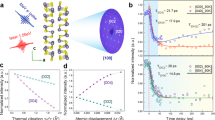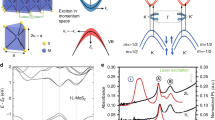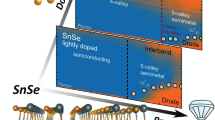Abstract
Nanoscale structures can produce extreme strain that enables unprecedented material properties, such as tailored electronic bandgap1,2,3,4,5, elevated superconducting temperature6,7 and enhanced electrocatalytic activity8,9. While uniform strains are known to elicit limited effects on heat flow10,11,12,13,14,15, the impact of inhomogeneous strains has remained elusive owing to the coexistence of interfaces16,17,18,19,20 and defects21,22,23. Here we address this gap by introducing inhomogeneous strain through bending individual silicon nanoribbons on a custom-fabricated microdevice and measuring its effect on thermal transport while characterizing the strain-dependent vibrational spectra with sub-nanometre resolution. Our results show that a strain gradient of 0.112% per nanometre could lead to a drastic thermal conductivity reduction of 34 ± 5%, in clear contrast to the nearly constant values measured under uniform strains10,12,14,15. We further map the local lattice vibrational spectra using electron energy-loss spectroscopy, which reveals phonon peak shifts of several millielectron-volts along the strain gradient. This unique phonon spectra broadening effect intensifies phonon scattering and substantially impedes thermal transport, as evidenced by first-principles calculations. Our work uncovers a crucial piece of the long-standing puzzle of lattice dynamics under inhomogeneous strain, which is absent under uniform strain and eludes conventional understanding.
This is a preview of subscription content, access via your institution
Access options
Access Nature and 54 other Nature Portfolio journals
Get Nature+, our best-value online-access subscription
$29.99 / 30 days
cancel any time
Subscribe to this journal
Receive 51 print issues and online access
$199.00 per year
only $3.90 per issue
Buy this article
- Purchase on Springer Link
- Instant access to full article PDF
Prices may be subject to local taxes which are calculated during checkout




Similar content being viewed by others
Data availability
Codes central to the main work described in this manuscript are deposited in Code Ocean (https://codeocean.com/capsule/9335891/tree). Source data are provided with this paper.
References
Balaghi, L. et al. Widely tunable GaAs bandgap via strain engineering in core/shell nanowires with large lattice mismatch. Nat. Commun. 10, 2793 (2019).
Conesa-Boj, S. et al. Boosting hole mobility in coherently strained [110]-oriented Ge–Si core–shell nanowires. Nano Lett. 17, 2259–2264 (2017).
Zhu, C. et al. Strain engineering in perovskite solar cells and its impacts on carrier dynamics. Nat. Commun. 10, 815 (2019).
Jiang, J. et al. Synergistic strain engineering of perovskite single crystals for highly stable and sensitive X-ray detectors with low-bias imaging and monitoring. Nat. Photonics 16, 575–581 (2022).
Jiang, M. et al. Strain-regulated Gibbs free energy enables reversible redox chemistry of chalcogenides for sodium ion batteries. Nat. Commun. 13, 5588 (2022).
Li, J., Shan, Z. & Ma, E. Elastic strain engineering for unprecedented materials properties. MRS Bull. 39, 108–114 (2014).
Choi, E.-M. et al. 3D strain-induced superconductivity in La2CuO4+δ using a simple vertically aligned nanocomposite approach. Sci. Adv. 5, eaav5532 (2019).
Ling, T. et al. Activating cobalt(II) oxide nanorods for efficient electrocatalysis by strain engineering. Nat. Commun. 8, 1509 (2017).
Wu, G. et al. In-plane strain engineering in ultrathin noble metal nanosheets boosts the intrinsic electrocatalytic hydrogen evolution activity. Nat. Commun. 13, 4200 (2022).
Zhou, Y., Dong, Z. Y., Hsieh, W. P., Goncharov, A. F. & Chen, X. J. Thermal conductivity of materials under pressure. Nat. Rev. Phys. 4, 319–335 (2022).
Li, S. et al. Anomalous thermal transport under high pressure in boron arsenide. Nature 612, 459–464 (2022).
Li, X., Maute, K., Dunn, M. & Yang, R. Strain effects on the thermal conductivity of nanostructures. Phys. Rev. B 81, 245318 (2010).
Parrish, K. D., Jain, A., Larkin, J. M., Saidi, W. A. & McGaughey, A. J. H. Origins of thermal conductivity changes in strained crystals. Phys. Rev. B 90, 235201 (2014).
Hohensee, G. T., Fellinger, M. R., Trinkle, D. R. & Cahill, D. G. Thermal transport across high-pressure semiconductor-metal transition in Si and Si0.991Ge0.009. Phys. Rev. B 91, 205104 (2015).
Murphy, K. F., Piccione, B., Zanjani, M. B., Lukes, J. R. & Gianola, D. S. Strain- and defect-mediated thermal conductivity in silicon nanowires. Nano Lett. 14, 3785–3792 (2014).
Lee, S. M., Cahill, D. G. & Venkatasubramanian, R. Thermal conductivity of Si–Ge superlattices. Appl. Phys. Lett. 70, 2957 (1998).
Abramson, A. R., Tien, C. L. & Majumdar, A. Interface and strain effects on the thermal conductivity of heterostructures: A molecular dynamics study. J. Heat Transfer 124, 963–970 (2002).
Hopkins, P. E. et al. Effects of coherent ferroelastic domain walls on the thermal conductivity and Kapitza conductance in bismuth ferrite. Appl. Phys. Lett. 102, 121903 (2013).
Sarantopoulos, A., Ong, W.-L., Malen, J. A. & Rivadulla, F. Effect of epitaxial strain and vacancies on the ferroelectric-like response of CaTiO3 thin films. Appl. Phys. Lett. 113, 182902 (2018).
Ning, S. et al. Anomalous defect dependence of thermal conductivity in epitaxial WO3 thin films. Adv. Mater. 31, 1903738 (2019).
Carruthers, P. Theory of thermal conductivity of solids at low temperatures. Rev. Mod. Phys. 33, 92 (1961).
Herring, C. Role of low-energy phonons in thermal conduction. Phys. Rev. 95, 954 (1954).
Klemens, P. G. The scattering of low-frequency lattice waves by static imperfections. Proc. Phys. Soc. A 68, 1113–1128 (1955).
Dai, Z., Liu, L. & Zhang, Z. Strain engineering of 2D materials: issues and opportunities at the interface. Adv. Mater. 31, 1805417 (2019).
Moore, A. L. & Shi, L. Emerging challenges and materials for thermal management of electronics. Mater. Today 17, 163–174 (2014).
Pop, E. Energy dissipation and transport in nanoscale devices. Nano Res. 3, 147–169 (2010).
Chu, M., Sun, Y., Aghoram, U. & Thompson, S. E. Strain: a solution for higher carrier mobility in nanoscale MOSFETs. Annu. Rev. Mater. Res. 39, 203–229 (2009).
Gu, X., Li, X. & Yang, R. Phonon transmission across Mg2Si/Mg2Si1-xSnx interfaces: a first-principles-based atomistic Green’s function study. Phys. Rev. B 91, 205313 (2015).
Capinski, W. S. & Maris, H. J. Thermal conductivity of GaAs/AlAs superlattices. Physica B Condens. Matter 219–220, 699–701 (1996).
Li, H. et al. Optoelectronic crystal of artificial atoms in strain-textured molybdenum disulphide. Nat. Commun. 6, 7381 (2015).
Krivanek, O. L. et al. Vibrational spectroscopy in the electron microscope. Nature 514, 209–212 (2014).
Venkatraman, K., Levin, B. D. A., March, K., Rez, P. & Crozier, P. A. Vibrational spectroscopy at atomic resolution with electron impact scattering. Nat. Phys. 15, 1237–1241 (2019).
Haas, B. et al. Atomic-resolution mapping of localized phonon modes at grain boundaries. Nano Lett. 23, 5975–5980 (2023).
Qi, R. et al. Four-dimensional vibrational spectroscopy for nanoscale mapping of phonon dispersion in BN nanotubes. Nat. Commun. 12, 1179 (2021).
Qi, R. et al. Measuring phonon dispersion at an interface. Nature 599, 399–403 (2021).
Yang, L. et al. Thermal conductivity of individual silicon nanoribbons. Nanoscale 8, 17895–17901 (2016).
Yang, L. et al. Kink as a new degree of freedom to tune the thermal conductivity of Si nanoribbons. J. Appl. Phys. 126, 155103 (2019).
Shi, L. et al. Measuring thermal and thermoelectric properties of one-dimensional nanostructures using a microfabricated device. J. Heat Transfer 125, 881–888 (2003).
Yang, L. et al. Observation of superdiffusive phonon transport in aligned atomic chains. Nat. Nanotechnol. 16, 764–768 (2021).
Yang, L. et al. High thermoelectric figure of merit of porous Si nanowires from 300 to 700 K. Nat. Commun. 12, 3926 (2021).
Liu, L.-C., Huang, M.-J., Yang, R., Jeng, M.-S. & Yang, C.-C. Curvature effect on the phonon thermal conductivity of dielectric nanowires. J. Appl. Phys. 105, 104313 (2009).
Gao, P. et al. Atomic-scale measurement of flexoelectric polarization at SrTiO3 dislocations. Phys. Rev. Lett. 120, 267601 (2018).
Yan, X. et al. Single-defect phonons imaged by electron microscopy. Nature 589, 65–69 (2021).
Wu, Y. et al. Lattice strain advances thermoelectrics. Joule 3, 1276–1288 (2019).
Wu, Y. et al. Thermoelectric enhancements in PbTe alloys due to dislocation-induced strains and converged bands. Adv. Sci. 7, 1902628 (2020).
Kresse, G. & Joubert, D. From ultrasoft pseudopotentials to the projector augmented-wave method. Phys. Rev. B 59, 1758–1775 (1999).
Li, W., Carrete, J., Katcho, N. A. & Mingo, N. ShengBTE: a solver of the Boltzmann transport equation for phonons. Comput. Phys. Commun. 185, 1747–1758 (2014).
Niquet, Y.-M., Delerue, C. & Krzeminski, C. Effects of strain on the carrier mobility in silicon nanowires. Nano Lett. 12, 3545–3550 (2012).
Dabov, K., Foi, A., Katkovnik, V. & Egiazarian, K. Image denoising by sparse 3-D transform-domain collaborative filtering. IEEE Trans. Image Process. 16, 2080–2095 (2007).
Hall, M. M. Jr, Veeraraghavan, V. G., Rubin, H. & Winchell, P. G. The approximation of symmetric X-ray peaks by Pearson type VII distributions. J. Appl. Cryst. 10, 66–68 (1977).
Bellido, E. P., Rossouw, D. & Botton, G. A. Toward 10 meV electron energy-loss spectroscopy resolution for plasmonics. Microsc. Microanal. 20, 767–778 (2014).
Mingo, N., Esfarjani, K., Broido, D. A. & Stewart, D. A. Cluster scattering effects on phonon conduction in graphene. Phys. Rev. B 81, 045408 (2010).
Kundu, A., Mingo, N., Broido, D. A. & Stewart, D. A. Role of light and heavy embedded nanoparticles on the thermal conductivity of SiGe alloys. Phys. Rev. B 84, 125426 (2011).
Stern, R., Wang, T., Carrete, J., Mingo, N. & Madsen, G. K. H. Influence of point defects on the thermal conductivity in FeSi. Phys. Rev. B 97, 195201 (2018).
Katre, A., Carrete, J., Wang, T., Madsen, G. K. H. & Mingo, N. Phonon transport unveils the prevalent point defects in GaN. Phys. Rev. Mater. 2, 050602(R) (2018).
Polanco, C. A. & Lindsay, L. Thermal conductivity of InN with point defects from first-principles. Phys. Rev. B 98, 014306 (2018).
Polanco, C. A. & Lindsay, L. Ab initio phonon point defect scattering and thermal transport in graphene. Phys. Rev. B 97, 014303 (2018).
Protik, N. H., Carrete, J., Katcho, N. A., Mingo, N. & Broido, D. Ab initio study of the effect of vacancies on the thermal conductivity of boron arsenide. Phys. Rev. B 94, 045207 (2016).
Guo, R. & Lee, S. Mie scattering of phonons by point defects in IV-VI semiconductors PbTe and GeTe. Mater. Today Phys. 12, 100177 (2020).
Economou, E. N. Green’s Functions in Quantum Physics, Vol. 7 (Springer, 2006).
Kresse, G. & Furthmüller, J. Efficient iterative schemes for ab initio total-energy calculations using a plane-wave basis set. Phys. Rev. B 54, 11169–11186 (1996).
Kresse, G. & Furthmüller, J. Efficiency of ab-initio total energy calculations for metals and semiconductors using a plane-wave basis set. Comput. Mater. Sci. 6, 15–50 (1996).
Blöchl, P. E. Projector augmented-wave method. Phys. Rev. B 50, 17953–17979 (1994).
Perdew, J. P., Burke, K. & Ernzerhof, M. Generalized gradient approximation made simple. Phys. Rev. Lett. 77, 3865–3868 (1996).
Acknowledgements
We thank the College of Engineering, Peking University, for its support. P.G. and J.D. acknowledge support from National Natural Science Foundation of China (52125307, 12004010) and the National Key R&D Program of China (2019YFA0708200, 2021YFB3501500). P.G. acknowledges support from the New Cornerstone Science Foundation through the XPLORER PRIZE. We thank B. Liao for the helpful discussion regarding the theoretical modelling on the effects of inhomogeneous strain. We thank R. Shi and R. Qi for helping with EELS data processing. We thank X. Sun for helping with schematic drawing. We acknowledge the Electron Microscopy Laboratory of Peking University, China, for the use of Cs corrected Nion U-HERMES200 scanning transmission electron microscopy.
Author information
Authors and Affiliations
Contributions
L.Y. proposed and directed the research. L.Y. fabricated the Si nanoribbons and performed thermal conductivity measurements while working in D.L.’s lab. J.D. performed EELS measurements and analysis, electron diffraction, and GPA analysis under the direction of P.G. S.Q. carried out the preparation of TEM samples and helped with data processing. H.L. and Z.D. conducted strain distribution analyses. S.Y., Y.T. and L.Y. performed theoretical modelling. The manuscript was prepared and revised by L.Y., J.D., S.Y., D.L. and P.G. with input from all co-authors.
Corresponding authors
Ethics declarations
Competing interests
The authors declare no competing interests.
Peer review
Peer review information
Nature thanks Roman Anufriev, Benedikt Haas and the other, anonymous, reviewer(s) for their contribution to the peer review of this work. Peer reviewer reports are available.
Additional information
Publisher’s note Springer Nature remains neutral with regard to jurisdictional claims in published maps and institutional affiliations.
Extended data figures and tables
Extended Data Fig. 1 HRTEM examination showing the single crystalline nature of the bent SiNR.
(a) TEM image of a bent SiNR. (a1-a7) HRTEM images covering the full width of the examined region for the bent SiNR in (a), and the blue dashed rectangles in (a) mark the different locations along the length of the bent SiNR for HRTEM tests.
Extended Data Fig. 2 SAED patterns of a bent SiNR.
(a1-a5) SAED patterns of the bent SiNR, where the inserts show the corresponding portion of the sample in Extended Data Fig. 1 within the selected aperture with diameter of ~180 nm.
Extended Data Fig. 3 Stress-free sample.
(a) SEM image of the stress-free straight Si nanoribbon sample, where the ends are treated with EBID Pt/C composite to minimize the effects of contact thermal resistance. (b) SEM image of the stress-free kinked Si nanoribbon sample. Note that the kinked Si nanoribbon are patterned with 90° kink angle, and thus the straight dashed line delineating on the ribbon edge as well as 90° kink angle formed between the two kink arms suggest this kinked ribbon is in stress-free condition.
Extended Data Fig. 4 Measured EELS map of the transverse acoustic mode under bending.
(a) HAADF image for the bent Si nanoribbon without kink, and the calculated strain contour is overlaid on top to visualize the strain distribution. The yellow rectangle represents the area where the EELS signals are acquired by summing each column spectra of the three-dimension dataset along the axial direction (perpendicular to the strain gradient direction) to enhance the signal-to-noise ratio. (b) The vibrational spectra map for the transverse acoustic (TA) mode along the beam shift direction. (c) Measured EELS profiles for the TA phonon mode along the strain gradient, which shows a peak shift from 25.8 meV to 28.3 meV as the strain changes from -2.78% to 2.65%.
Extended Data Fig. 5 Calculated phonon density of states under elastic strain.
(a) Calculated phonon density of states (PDOS) of Si atoms as the elastic strain changes from 4.77% to −4.77%. (b) Extracted TO peak position for the measured bent SiNR with kink in Fig. 3b–d as a function of elastic strain, where the theoretically calculated peak position for the TO mode is also plotted for comparison. Error bars represent the peak fitting error. Note that the slight discrepancy between the experimental results and theoretical calculation could be caused by local uniform strain approximations in DFT to reproduce the inhomogeneous strain distribution in bent Si nanoribbons, and measurement uncertainties in EELS due to the limited energy resolutions, as well as errors introduced during background subtraction and phonon peak fitting.
Extended Data Fig. 6 Bent Si nanoribbon sample preparation procedures.
(a-b) A Si nanoribbon initially rested on a PDMS substrate and was picked up by a microprobe through van der Waals interaction. (c) The ribbon sample was placed on the suspended microdevice to bridge the gap of the two suspended membranes. (d) The nanoribbon was inverted to present its thickness side upward using the microprobe. (e) One end of the ribbon adhered well with the underlying electrode via van der Waals interaction, and the other end was moved by the microprobe to achieve the desired bending configuration. (f) The two ends of the bent ribbon were fixed with the underlying electrode through focused electron beam induced deposition (EBID) of Pt/C composite.
Extended Data Fig. 7 Contact thermal resistance characterization.
SEM images of the 34 nm thick, 85 nm wide kinked SiNR with suspended length, L, of (a) 3.8 μm, and (b) 10.1 μm, respectively. (c) SEM image of the (34, 85) kinked SiNR with suspended length of 4.7 μm. The electron beam induced deposition (EBID) of Pt/C composite is performed at the two ends. (d) Measured thermal conductivity of the three samples in (a-c) in the temperature range from 50–400 K, where the close thermal conductivity indicates the negligible contribution from the contact thermal resistance.
Extended Data Fig. 8 Phonon frequency broadening as a function of elastic strain difference.
Calculated absolute value of phonon frequency broadening for TA, LA, and TO (LO) modes as a function of strain difference at the selected q-points of (a) (0.5, 0.5, 0.0) and (b) (0.75, 0.5, 0.25), respectively. As the elastic strain is linearly distributed along the thickness direction for a bent Si nanoribbon (Supplementary Fig. 3), and the phonon frequency shift is linearly dependent on elastic strain, this in turn validates our assumption that the broadened phonon spectra are linearly distributed in real space.
Supplementary information
Supplementary Information
This file contains Supplementary Figs 1–12, Supplementary Sections 1–6 and Supplementary References.
Supplementary Video 1
Bent SiNR sample preparation procedures. An illustration video showing the bent Si nanoribbon sample preparation process on the suspended microdevice.
Rights and permissions
Springer Nature or its licensor (e.g. a society or other partner) holds exclusive rights to this article under a publishing agreement with the author(s) or other rightsholder(s); author self-archiving of the accepted manuscript version of this article is solely governed by the terms of such publishing agreement and applicable law.
About this article
Cite this article
Yang, L., Yue, S., Tao, Y. et al. Suppressed thermal transport in silicon nanoribbons by inhomogeneous strain. Nature (2024). https://doi.org/10.1038/s41586-024-07390-4
Received:
Accepted:
Published:
DOI: https://doi.org/10.1038/s41586-024-07390-4
Comments
By submitting a comment you agree to abide by our Terms and Community Guidelines. If you find something abusive or that does not comply with our terms or guidelines please flag it as inappropriate.



